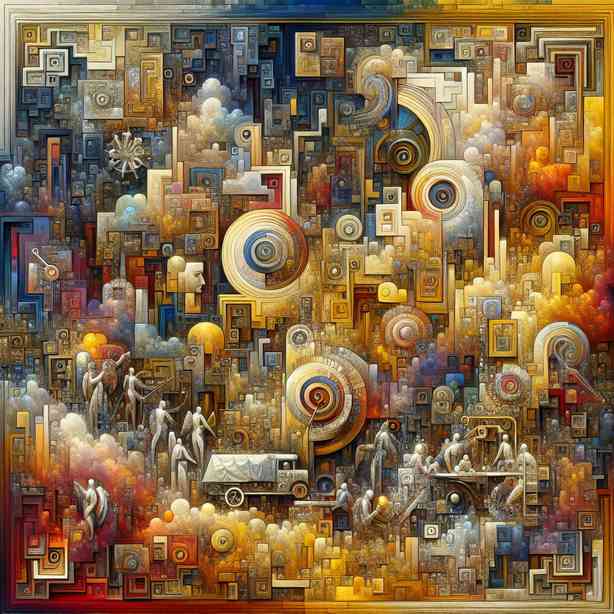
Title: That One Painting That Took a Month to Title
In the world of art, the process of creation is often as fascinating as the final piece itself. Among the myriad of pieces that have garnered attention over the centuries, there is one particular painting that stands out not just for its aesthetics but for the remarkable journey it took to finally receive a title. This painting, which has left art enthusiasts pondering and discussing for weeks, serves as a testimony to the complexity of interpreting art and the themes that it encapsulates. Let us delve deeper into the intricacies of this artwork, the artist’s intentions, the various interpretations it has inspired, and the lengthy process behind its title.
The painting in question, created by an acclaimed contemporary artist, challenges viewers to engage actively with its visual narrative. This artwork is a dramatic exploration of human emotion, societal norms, and the ever-evolving relationship between humanity and nature. When the artist completed the work, it was clear that the painting had the potential to evoke a range of reactions and interpretations. However, the journey of this artwork was far from straightforward. While the colors, shapes, and themes made an immediate impact, deciding on a fitting title took an astonishing month of deliberation.
Titles in the art world are of paramount importance. They serve as a bridge between the artist’s intentions and the viewer’s experience. A title has the power to frame how we interpret a piece, guiding our emotions and thoughts in specific directions. The artist recognized this responsibility and wanted to ensure that the title reflected not just the superficial aspects of the painting but also the deeper meanings embedded within it. The narrative behind the title is just as compelling as the visual aspect of the painting itself, revealing the labor of love that the artist poured into both.
Initially, the artist experimented with various titles that alluded to the dominant themes in the work. Some titles were literal, directly referencing the prominent elements present in the painting. Others were abstract, attempting to capture the emotional undertones without anchoring it to any specific visual motifs. However, none of these suggestions felt quite right; they all fell short of encapsulating the multifaceted essence of the piece. This struggle led to numerous brainstorming sessions, conversations with fellow artists, and introspective moments that challenged the artist’s own perspective on their work.
As the weeks went by, the artist immersed themselves in a process of reflection, seeking inspiration from literature, philosophy, and personal experiences that resonated with the painting. This quest for the perfect title became a journey in itself, leading to moments of revelation and insight that deepened the artist’s connection to the artwork. Discussions with other creatives illuminated different interpretations, highlighting how diverse perspectives could shift the meaning of the painting and, consequently, the title that would best represent it.
The dialogue surrounding the title extended beyond the studio walls. The artist engaged with a community of art lovers and critics who were eager to speculate on what the title might be. This interaction not only created a buzz but also revealed how people’s individual experiences can influence their understanding of the piece. While the painting sparked vibrant discussions, the anticipation surrounding its title added an additional layer of intrigue, prompting wider engagement with the art form itself.
Eventually, a breakthrough came when the artist stumbled upon a phrase in a poem that resonated deeply with the emotional core of the painting. This phrase encapsulated the juxtaposition of struggle and beauty, encapsulating the essence of what they sought to convey through their work. However, even after identifying this phrase, the artist contemplated whether it was indeed the most fitting choice. They sought feedback from trusted peers who were immersed in the art world, and through these discussions, the title began to morph into something more profound, evolving from a simple phrase into a lyrical representation of the painting’s spirit.
Once a consensus was reached, and the title was finally solidified, a sense of relief washed over the artist. They realized that the journey of titling the painting had reinforced their understanding of the work itself. Each iteration of possible titles had added depth to the dialogue surrounding the artwork, enriching its narrative layers. The title was not merely a label; it became an integral part of the artwork’s identity, allowing viewers to engage with it on a more intimate level.
After the title’s unveiling, the painting garnered even more attention within the art community. Critics began analyzing not only the visual components but also the intricacies of the title’s implications, exploring how it connected all the elements in the artwork. The synergy between the painting and its title prompted a wealth of interpretations, inviting viewers to reflect on their own experiences and perceptions.
In retrospection, the time spent deliberating on the title was essential in elevating the artwork beyond a visual experience. It added layers of meaning that transformed the interaction between the viewer and the piece, fostering a dialogue that would extend well beyond its exhibition. This experience demonstrated that art is not just about the creation; it is about the engagement it inspires and the conversations it ignites.
In conclusion, the story behind that one painting that took a month to title serves as a poignant reminder of the complexities involved in art creation. From the artistic process to the thoughtful selection of a title, every aspect contributes to how we perceive and understand a piece. The journey of interpretation and the exploration of meaning highlight the depth of human creativity. By investing time and energy into the relationship between the artwork and its title, we recognize art’s ability to transcend time and provoke thought, ultimately fostering a deeper connection between the artist, the artwork, and the audience. Such narratives enrich the artistic landscape, inviting us to appreciate not just the final product, but the intricate paths that lead us there.


